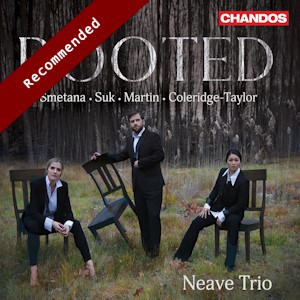
Rooted
Bedřich Smetana (1824-1884)
Piano Trio, Op.15 (1855, revised 1857)
Samuel Coleridge-Taylor (1875-1912)
Five Negro Melodies for Piano Trio (c.1905)
Josef Suk (1874-1935)
Petit Trio, Op.2 for Piano, Violin and Cello (1889, revised 1890-1891)
Frank Martin (1890-1974)
Trio on Popular Irish Melodies for Piano, Violin and Cello (1925)
Neave Trio
rec. 2023, Potton Hall, Dunwich, UK
Chandos CHAN20272 [76]
It is not for nothing that Czechia’s prestigious music festival, the Prague Spring, opens every year with Bedřich Smetana’s cycle of symphonic poems Má vlast (My Country). He holds the place in the nation’s heart as the father of its music. But for all of Má vlast’s success, the real pulse of this national treasure resides, as is often the case, in his chamber music. In this genre, many composers express their feelings on a range of issues, from personal loss to political criticism and much besides. Smetana’s 1876 autobiographical string quartet From My Life, cataloguing his sudden loss of hearing, came two decades after this piano trio, which he wrote in a few weeks, in the wake of the tragic loss of his four-year-old daughter to scarlet fever. One hopes the composition helped the grieving father come to terms with the loss. And we can revel in the movingly brilliant music which so poignantly conveys Smetana’s sadness.
The first movement begins with the violin’s searing, heart-rending tune, soon joined by the cello and piano which mirror the achingly sad atmosphere. The devastation is briefly rendered sweet, maybe to evoke the delight the little girl had brought to the world, but the dark mood returns. The regularly reintroduced opening theme recalls its core message. The piano (Smetana played the instrument at the première) offers a short oasis of calm. Then the violin brings back a poignant reminder of the subtext but with a gentle outer coating, as the movement comes to a tearful conclusion.
The second movement’s first section, lighter in mood, brings to mind the joy Smetana’s daughter gave her parents. The second section abruptly reinjects the seriousness; it reintroduces elements of the opening movement in a delicately beautiful rendition. The finale’s theme comes from Smetana’s piano sonata from ten years before. Together with a second theme, the mood is overall light, even hopeful. But the tragedy, never far from the surface, is easily brought back by subtly changing the character of the melody as the trio reaches a sober conclusion.
Samuel Coleridge-Taylor’s cantata Hiawatha’s Wedding Feast is no longer one of his few regularly programmed pieces – finally! Five Negro Melodies begin with the ever-popular spiritual Sometimes I Feel Like a Motherless Child. It enjoys a place in the great American song-book; Nina Simone’s version is especially poignant. In Coleridge-Taylor’s version, string writing is very effective. The cello joins the violin in high register. The piano accompanies them, and later has its time to underline the main theme. The cello acts as the lead in I Was Way Down A-Yonder,which represents the Black voice, so effective in expressing emotion with rich timbres. Didn’t My Lord Deliver Daniel has a bold aspect. They Will Not Lend Me a Child is richly presented and melodically poignant; brilliantly effective writing for strings brings out the essence of the number. My Lord Delivered Daniel, apowerful conclusion, fuses the elements of a hymn with a declaration of assent.
When I lived in Prague in the late 1970s, I was lucky to see violinist Josef Suk perform at the Prague Spring festival and elsewhere. His great-grandfather was none other than Antonín Dvořák, and his grandfather was composer Josef Suk. I remember I enjoyed getting to know the elder Suk’s Asrael Symphony. His Petit Trio opens with a serious tune, turning much gentlerwith the cello via its second theme. The violin and piano join in the more upbeat mood despite the pervading feeling of longing.
The writing explains why Dvořák considered Suk the favourite pupil. His influence is strongly felt in the overriding lyricism and captivating melodies, which Suk was particularly adept in creating. That shows even more strongly in the short, deliciously tuneful second movement which comes to an end with a firm restatement of the trio’s opening theme. The finale opens with a bouncy tune; some magical rhythms delight the ear. The trio ends on a positive note, never mind inward questioning elements along the way.
Frank Martin based his trio on Irish tunes, compulsive in their simplicity and their delightful rhythms. His undoubted skill brings out the most pertinent elements, and creates propulsive excitement in each of the three short movements. I have been delighted to have made this work’s acquaintance. Others new to this trio will, I am certain, be equally thrilled by its infectious energy and gorgeous tunes.
The Neave Trio have delivered a truly magical disc with four of the loveliest of trios. I especially found Smetana’s work a fantastic listen. Its emotional content manifests itself most effectively. What with the crisp sound, this is a disc to savour.
Steve Arloff
Buying this recording via a link below generates revenue for MWI, which helps the site remain free




















